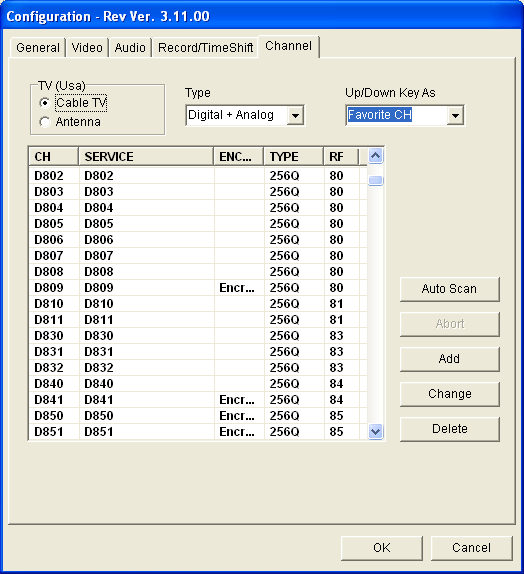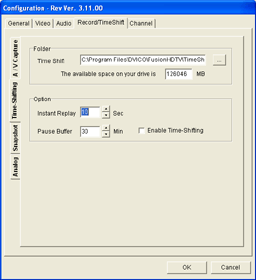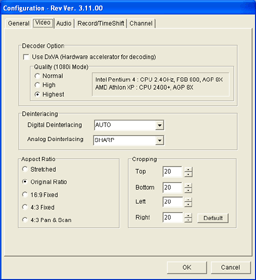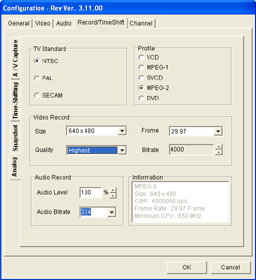HTPC - TV Tuner Reviews
by Jarred Walton on December 7, 2005 12:05 AM EST- Posted in
- Smartphones
- Mobile
DVICO Fusion5 Gold (cont'd)
The Fusion5 card can function in multiple ways, and how you plan to use the card will affect the configuration process. FusionHDTV supports standard analog TV reception, OTA DTV reception, and the ability to decode digital cable content (provided that it isn't encrypted). These last two features are also referred to as the ability to decode 64/256 bit QAM content (for digital cable) and 8VSB content (for OTA DTV).
When you first launch FusionHDTV, it will ask if you want to scan for channels. Say "no" and then specify the type of connection that you're using first: cable or antenna, and then select analog, digital or both for the channel type. At this point, you can click the "Start Scan" button and wait a few minutes. (It took about 4.5 minutes to scan through the digital channels and another 1.5 minutes for the analog channels.)
Most of the configuration options are pretty much self-explanatory. You can see several of the screens above. Timeshifting is grayed out on analog channels but is available for digital channels. Depending on which station you're currently tuned in to, you may or may not be able to check the timeshifting box.
The video options allow you to specify how the content should be shown. "Original Ratio" is our preferred choice, as any form of stretching tends to look bad. Some people don't like having black areas on widescreen displays, though, so the ability to switch to a stretch or zoom mode will keep them happy. The remote actually has a button that toggles between these three modes, which can come in handy.
Digital and analog recording have separate options, although the computer speed may play a role in what you select. You can capture digital streams as either the raw transport stream (with a .TP extension) or as a "Native MPEG" stream. "Native MPEG" mode converts the transport stream to a program stream (.MPEG extension), which usually has very little impact on performance or file size (and no impact on quality). However, it can save a lot of space if you're capturing an SDTV show where there are lots of extra bytes for other subchannels or null packets in the TS that are stripped from the PS. Given this information, Native MPEG seems to be the better choice, though in our sample videos (which were of HDTV), we chose to capture the raw TS.
Analog capture only allows MPEG2 encoding, but with several quality presets available. Choosing 640x480 and Highest Quality result in a data rate of 4000 Kbits/s and little to no loss in quality, so that's what we chose. That will use around 30 MB per minute of video - that's one-fourth to one-fifth the amount of disk space as a typical 720p/1080i HD transport stream, in case you were wondering. With hard drives costing around 40 cents per GB for the best deals, we recommend grabbing a 250GB drive (or several) and using higher quality capture options rather than worrying about disk space.
The Fusion5 card can function in multiple ways, and how you plan to use the card will affect the configuration process. FusionHDTV supports standard analog TV reception, OTA DTV reception, and the ability to decode digital cable content (provided that it isn't encrypted). These last two features are also referred to as the ability to decode 64/256 bit QAM content (for digital cable) and 8VSB content (for OTA DTV).

When you first launch FusionHDTV, it will ask if you want to scan for channels. Say "no" and then specify the type of connection that you're using first: cable or antenna, and then select analog, digital or both for the channel type. At this point, you can click the "Start Scan" button and wait a few minutes. (It took about 4.5 minutes to scan through the digital channels and another 1.5 minutes for the analog channels.)
 |
 |
| Click to enlarge. | |
Most of the configuration options are pretty much self-explanatory. You can see several of the screens above. Timeshifting is grayed out on analog channels but is available for digital channels. Depending on which station you're currently tuned in to, you may or may not be able to check the timeshifting box.
The video options allow you to specify how the content should be shown. "Original Ratio" is our preferred choice, as any form of stretching tends to look bad. Some people don't like having black areas on widescreen displays, though, so the ability to switch to a stretch or zoom mode will keep them happy. The remote actually has a button that toggles between these three modes, which can come in handy.
 |
 |
| Click to enlarge. | |
Digital and analog recording have separate options, although the computer speed may play a role in what you select. You can capture digital streams as either the raw transport stream (with a .TP extension) or as a "Native MPEG" stream. "Native MPEG" mode converts the transport stream to a program stream (.MPEG extension), which usually has very little impact on performance or file size (and no impact on quality). However, it can save a lot of space if you're capturing an SDTV show where there are lots of extra bytes for other subchannels or null packets in the TS that are stripped from the PS. Given this information, Native MPEG seems to be the better choice, though in our sample videos (which were of HDTV), we chose to capture the raw TS.
Analog capture only allows MPEG2 encoding, but with several quality presets available. Choosing 640x480 and Highest Quality result in a data rate of 4000 Kbits/s and little to no loss in quality, so that's what we chose. That will use around 30 MB per minute of video - that's one-fourth to one-fifth the amount of disk space as a typical 720p/1080i HD transport stream, in case you were wondering. With hard drives costing around 40 cents per GB for the best deals, we recommend grabbing a 250GB drive (or several) and using higher quality capture options rather than worrying about disk space.










77 Comments
View All Comments
SynthDude2001 - Wednesday, December 7, 2005 - link
I'm glad to see some attention being given to HDTV tuners; this article is a pretty good primer for anyone considering getting one.I've personally owned the MyHD card (and DVI daughtercard) since February and I'm extremely happy with it. I do often recommend the Fusion 5 to others though, based on its very reasonable price ($99 or so for the Lite version).
highlandsun - Wednesday, December 7, 2005 - link
I've had a Dvico Fusion Gold-T for a few months, it was the immediate predecessor to the Fusion 5 card. So far I've only used it for analog reception since I haven't subscribed to digital service yet. (Comcast; there's no OTA reception here at all.) I installed everything and played with it for a short while, but have basically left it idle. The analog picture I get is much much grainier/noisier than on my Sony Wega TV, so I've not invested any more time into it. I did go so far as to rebuild my Linux kernel with the necessary Video4Linux drivers to get it working, but that's about it.I also have a Dazzle Firewire bridge, so I can use that to pipe the Sony's tuner output into the PC. That means I have to record in DV format, which is pretty disk hungry. I think now that I have an X2 3800+ I can probably transcode it to something else, but haven't tried it yet.
vijay333 - Wednesday, December 7, 2005 - link
good to see that the Sapphire Theatrix (based on the ATI 550 chipset) that I bought in July/August is still the best with regards to analog captures :)NordicNINE - Wednesday, December 7, 2005 - link
Since you're looking at doing a future article with a Nvidia IGP, I think this motherboard would be perfect. I just got a pair for the wife and my son and they seem great. Hi def audio & DVI out would make them perfect HDTV PC's. Too bad they don't make a socket 754 version to pair a Sempron with. Hopefully AMD will release a socket 939 Sempron soon. I'd def be interested in seeing how they'd handle it. I might need to get a couple more.JarredWalton - Wednesday, December 7, 2005 - link
Funny you mention that. It's precisely the motherboard I had in mind, as most of the NVIDIA 61x0 boards don't have built-in DVI ports. I'm a little irked that the TV/Component out is a separate option, though. The board I have didn't include the adapters, so I'll be focusing on the DVI port.segagenesis - Wednesday, December 7, 2005 - link
The quality is actually pretty impressive... its good to know its supported in BeyondTV also. Makes me really consider getting one when I build my PVR.segagenesis - Wednesday, December 7, 2005 - link
Too bad I cant edit my previous post. I downloaded that torrent of the video feeds and all I can say about the analogue capture from the PowerColor Theatre is... WOW! I dont even think the good ol Happauge WinTV PVR's were that good!